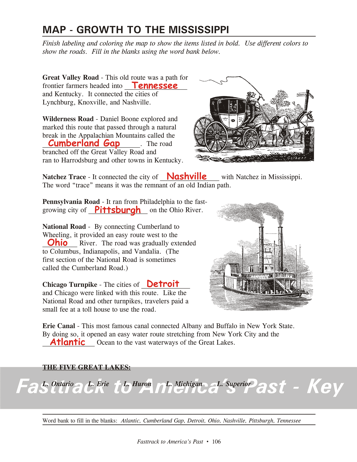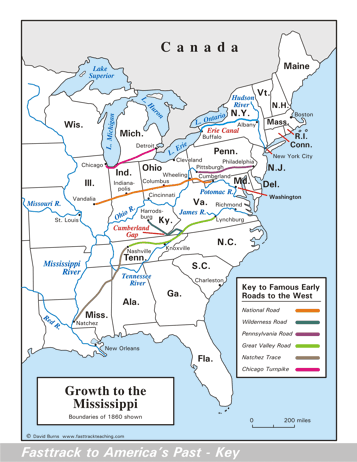| Fasttrack
to America's Past Teacher Key |
|
| Fasttrack
to America's Past Teacher Key |
|
 Page 106  Page 107 The map is shown
as it appears when completed by students using color
pencils. The
full size map that students will use to guide their work can be found
with the link on the main index page for this section.
Please read the "Tips for completing the map" in the next column. |
Pages 106
& 107 - Map - Growth to the Mississippi Map guide, page 106 Students should use the word bank at the bottom of the page as they work to complete the map guide's "fill in the blank" sentences. Great Valley Road - ...into Tennessee and... Wilderness Road - ...the Cumberland Gap. Natchez Trace - ...Nashville with... Pennsylvania Road - ...of Pittsburgh on... National Road - ...the Ohio River. Chicago Turnpike - ...of Detroit and... Erie Canal - ...the Atlantic Ocean... The pictures 1. A carriage on a road of the early 1800s. It was not a very comfortable way to travel. Even it good weather, it was a bumpy ride. When it rained, carriages sometimes got stuck in the mud, and passengers might be asked to get out and help push. 2. A steamboat like those that traveled the Mississippi and Ohio rivers. Notice the paddle wheels on this boat were on the sides - with some other designs, a single paddle wheel was in the back. Tips for completing the map, page 107 Students should
work from the full size, completed map page shown with the link from
this
section's main
index page.
Emphasize neatness from the beginning! This map shows some of the most famous roads
that took
Americans westward during the first half of the 19th century. It
also shows the Erie Canal. Remind students that it does not show
all the roads or canals of the period. Students should color the rivers with a dark blue pencil, and the larger bodies of water with a light blue pencil. |
|
Copyright Notice
Copyright 2018 by David Burns. All rights reserved. Illustrations and reading selections appearing in this work are taken from sources in the public domain and from private collections used by permission. Sources include: the Dover Pictorial Archive, the Library of Congress, The National Archives, The Hart Publishing Co., Corel Corporation and its licensors, Nova Development Corporation and its licensors, and others. Maps were created or adapted by the author using reference maps from the United States Geological Survey and Cartesia Software. Please see the home page for this title for more information. |